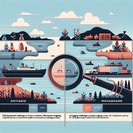
On November 3 Immigration, Refugees and Citizenship Canada (IRCC) published a revised list of countries whose nationals must undergo an Immigration Medical Exam (IME) when applying for temporary residence. Effective immediately, applicants who have lived in Argentina, Colombia, Uruguay or Venezuela for six consecutive months during the year prior to arriving in Canada must now complete an IME. Conversely, nationals of Armenia, Bosnia and Herzegovina, Iraq, Latvia, Lithuania and Taiwan are no longer subject to this requirement.
IRCC reviews its IME list annually using World Health Organization data on tuberculosis incidence and other public-health risks. The addition of the four South American countries signals a rising TB incidence rate above Canada’s risk tolerance threshold of 40 cases per 100,000 population. For employers, the change means that work-permit applicants originating from these jurisdictions should budget an extra two to four weeks to schedule a panel-physician appointment and wait for eMedical clearance.
![IRCC Adds Four Latin American Countries to Mandatory Medical-Exam List, Removes Six Others]()
The removal of six countries—three in Eastern Europe, one in the Middle East and a dynamic East-Asian economy—reflects sustained improvements in their public-health indicators and will shave roughly Can$230 off application costs for many travellers. Taiwanese exporters sending technicians to install equipment in Canada, for example, can now dispatch staff on short notice without navigating the medical-exam bottleneck.
Applicants who submitted complete files before November 3 remain grandfathered under the old rules, but immigration lawyers recommend attaching an explanatory letter to avoid processing delays if travel histories include the newly-added countries. Multinational mobility managers should update checklists, alert relocation vendors and revise global mobility timelines for Latin-America–to-Canada deployments initiated after the effective date.
From a policy standpoint, the revision illustrates Ottawa’s continuing shift toward risk-stratified immigration screening rather than one-size-fits-all requirements. Stakeholders expect IRCC to roll out a data-driven, region-specific medical-exam exemption pilot for low-risk applicants in 2026, pending the outcomes of the current review cycle.
IRCC reviews its IME list annually using World Health Organization data on tuberculosis incidence and other public-health risks. The addition of the four South American countries signals a rising TB incidence rate above Canada’s risk tolerance threshold of 40 cases per 100,000 population. For employers, the change means that work-permit applicants originating from these jurisdictions should budget an extra two to four weeks to schedule a panel-physician appointment and wait for eMedical clearance.

The removal of six countries—three in Eastern Europe, one in the Middle East and a dynamic East-Asian economy—reflects sustained improvements in their public-health indicators and will shave roughly Can$230 off application costs for many travellers. Taiwanese exporters sending technicians to install equipment in Canada, for example, can now dispatch staff on short notice without navigating the medical-exam bottleneck.
Applicants who submitted complete files before November 3 remain grandfathered under the old rules, but immigration lawyers recommend attaching an explanatory letter to avoid processing delays if travel histories include the newly-added countries. Multinational mobility managers should update checklists, alert relocation vendors and revise global mobility timelines for Latin-America–to-Canada deployments initiated after the effective date.
From a policy standpoint, the revision illustrates Ottawa’s continuing shift toward risk-stratified immigration screening rather than one-size-fits-all requirements. Stakeholders expect IRCC to roll out a data-driven, region-specific medical-exam exemption pilot for low-risk applicants in 2026, pending the outcomes of the current review cycle.











